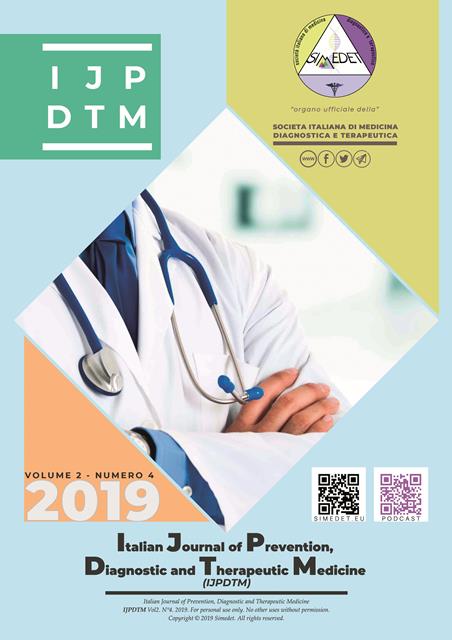Rischio tromboembolico in paziente medico una revisione approfondita e prospettive future
Contenuto principale dell'articolo
Abstract
Introduzione: diversi pazienti affetti da malattie mediche acute come insufficienza cardiaca congestizia, malattie respiratorie, malattie infettive o infiammatorie, mostrano un rischio tromboembolico venoso concreto, potenziale.
Metodi: molti studi hanno dimostrato una rilevante riduzione dell'embolia polmonare fatale a causa del miglioramento della pratica medica volta a fornire una corretta terapia profilattica tromboembolica.
Risultati: nonostante gli sforzi scientifici nella prevenzione clinica, l'influenza di alcune pazienti sulle variabili demografiche è spesso sottovalutata (vale a dire l'età avanzata ...) e l'onere reale del rischio tromboembolico venoso assoluto e l'efficacia tromboprofilattica rimangono poco chiari. Inoltre, l'istituzione e lo sviluppo di reparti di pronto soccorso e di cura acuta selezionano una popolazione di pazienti che mostra caratteristiche e comorbilità più complesse rispetto ai reparti di medicina classica, rendendo così più difficile la scelta esatta di quando e come somministrare la terapia profilattica tromboembolica.
Conclusione: la valutazione simultanea del rischio trombotico ed emorragico è la chiave per un'adeguata profilassi sicura, una maggiore appropriatezza della profilassi antitrombotica. Pertanto si raccomanda abitualmente di utilizzare strumenti adeguati per la valutazione del rischio di TEV al fine di stabilire la migliore strategia terapeutica rischio / beneficio nei pazienti con patologie mediche.
Downloads
Dettagli dell'articolo

Questo lavoro è fornito con la licenza Creative Commons Attribuzione - Non commerciale - Non opere derivate 4.0 Internazionale.
Riferimenti bibliografici
Haas SK (2002) Venous thromboembolic risk and its prevention in hospitalized medical patients. Semin Thromb. Hemost 28:577-584.
Geerts W SR. Prevention of Venous Thromboembolism in the ICU. Chest. 2003;124:357S-63S.
Cullen DJ, Nemeskal AR. The autopsy incidence of acute pulmonary embolism in critically ill surgical patients.Intensive Care Medicine.1986;12:299-303
Pengo V, Lensing AW, Prins MH et Al. Incidence of chronic thromboembolic pulmonary hypertension after pulmonary embolism.N Engl J Med. 2004;350(22):2257-64.
Geerts WH, Pineo GF, Heit JA et al. Prevention of venous thromboembolism: the seventh ACCP conference on antithrombotic and thrombolytic therapy. Chest 2004;126(suppl 3):338-400S.
Samama MM, Cohen AT, Darmon JY, et al.(1999) A comparison of enoxaparin with placebo for the prevention of venous thromboembolism in acutely ill medical patients: prophylaxis in Medical Patients with Enoxaparin Study Group. N Engl J Med.1999;341:793–800.
White RH ( 2003 ) The epidemiology of venous thromboembolism. Circ 17;107(23 Suppl 1):I4-8.
.
Anderson FA Jr, Decousus H, Bergmann JF,et al. A multinational observational cohort study in hospitalized medical patients of practices in prevention of venous thromboembolism and clinical outcomes: findings of the international medical prevention registry on venous thromboembolism (IMPROVE). ISTH Congress; J Thromb Haemostasis 2003;1(Suppl 1): P1438.
Oudega, R., Moons, K. G., Karel Nieuwenhuis,et al. Deep vein thrombosis in primary care: possible malignancy?The British journal of general practice : the journal of the Royal College of General Practitioners, 2006;56(530):693-6.
Tapson VF, Decousus H, Pini M, et al.Venous thromboembolism prophylaxis in acutely ill hospitalized medical patients: findings from the International Medical Prevention Registry on Venous Thromboembolism.Chest. 2007;132(3):936-45.
Cohen AT, Tapson VF, Bergmann JF, et al. Venous thromboembolism risk and prophylaxis in the acute hospital care setting (ENDORSE study): a multinational cross-sectional study.Lancet. 2008;371(9610):387-94.
Chopard P, Spirk D, Bounameaux H. Identifyng acutely ill medical patients requiring thromboprophylaxis. I Throm Haemost 2006;4:915-6.
Cohen AT, Zaw HM, Alikhan R. Benefits of deep-vein thrombosis prophylaxis in the nonsurgical patient: The MEDENOX trial. Semin Hematol. 2001;38(2 Suppl 5):31-8.
Cohen AT, Davidson BL, Gallus AS, et al. Efficacy and safety of fondaparinux for the prevention of venous thromboembolism in older acute medical patients: randomised placebo controlled trial. BMJ. 2006;332:325–9.
Kearon C., Akl E.A., Ornelas J. et al. Antithrombotic therapy for VTE disease: CHEST guideline and expert panel report 2.Chest.2016; 149(2) :315-52.
Spyropoulos AC, Raskob GE New paradigms in venous thromboprophylaxis of medically ill patients. Thromb Haemost.2017; 117:1662.
Nendaz M, Spirk D, Kucher N, et al. Multicentre validation of the Geneva Risk Score for hospitalised medical patients at risk of venous thromboembolism. Explicit ASsessment of Thromboembolic RIsk and Prophylaxis for Medical PATients in SwitzErland (ESTIMATE).Thromb Haemost 2014; 111: 531–8.
Cohen AT, Harrington RA, Goldhaber SZ, et al. Extended thromboprophylaxis with betrixaban in acutely ill medical patients. N Engl J Med. 2016;375(6):534–44.
Vincentelli, GM; Monti M, Pirro M.R.. et Al. Perception of the thromboembolism risk: the differences between the departments of internal and emergency medicine. Keio J Med. 2016;65(2):39-43.
Vincentelli GM, Timpone S, Murdolo G,et al. A new risk assessment model for the stratification of the thromboembolism risk in medical patients: the TEVERE score. Minerva Med. 2018;109(6):436-42.

